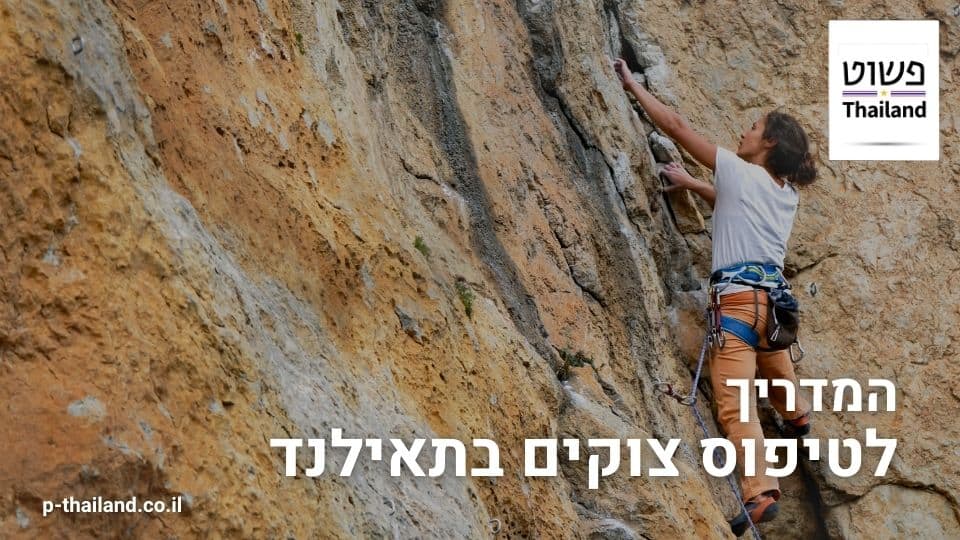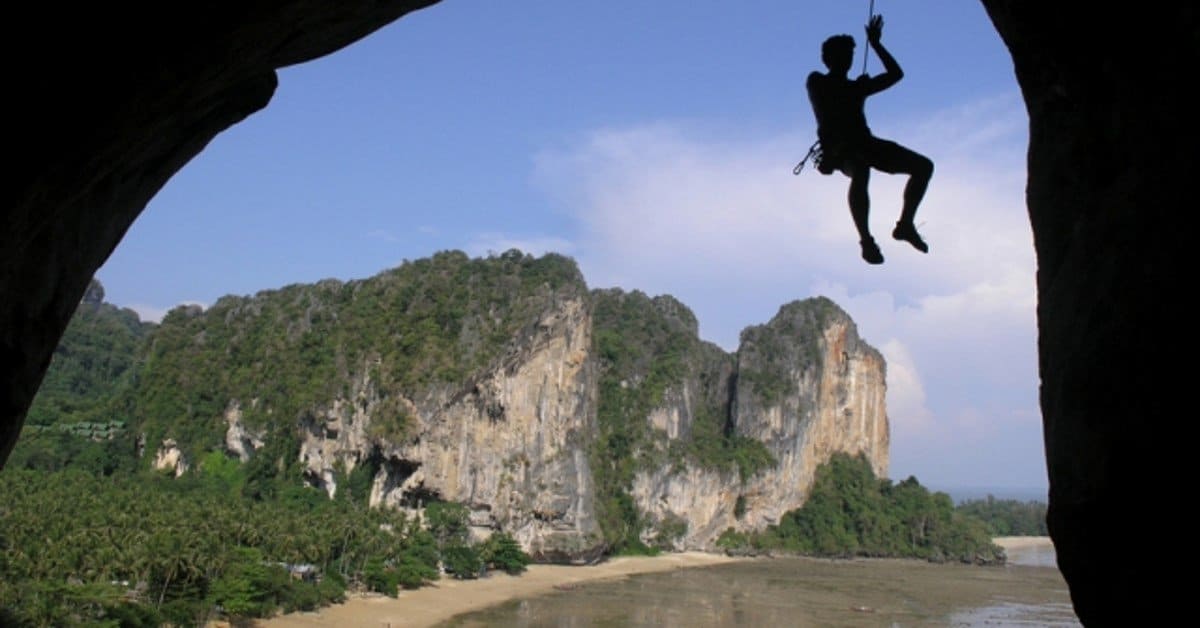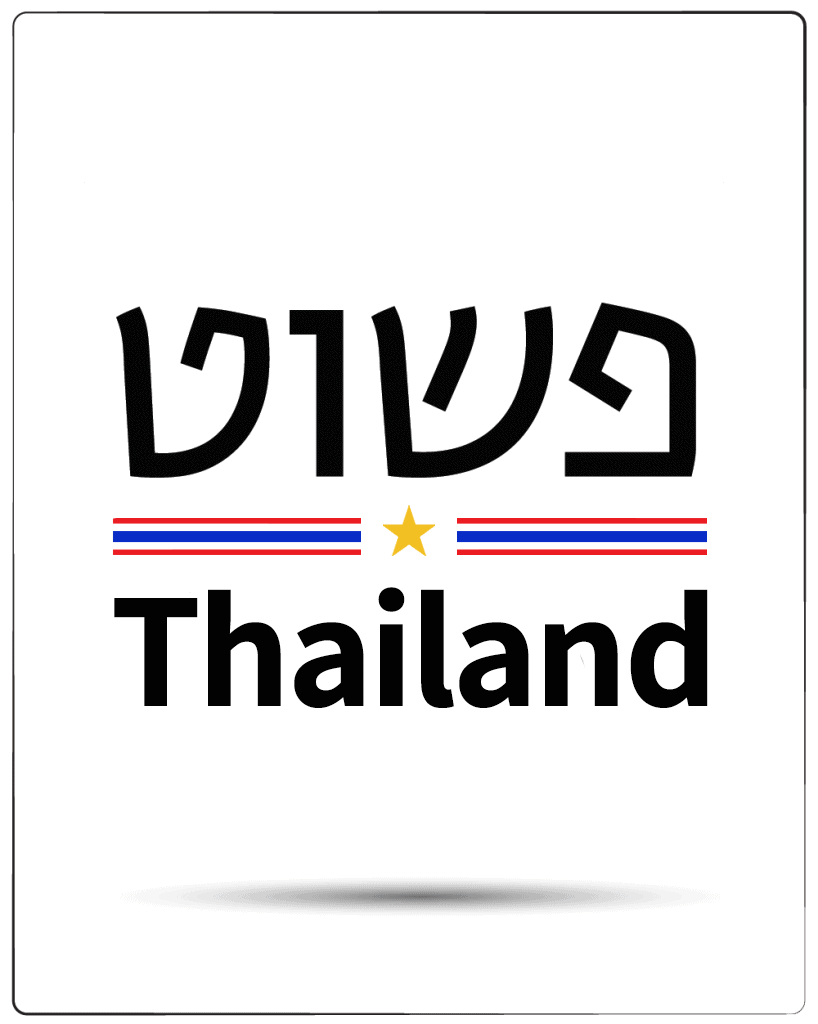When you think about Thailand An image of an exotic place with coconut trees, a chilled fruit smoothie, Pad Thai at a price that is ridiculous to mention, Shopping in thousands of markets, tanned young men and women lying on golden sands as the sun sinks into the turquoise water in front of them and they are decorated with phosphorescent body paints, and of course - a divine foot massage...
All of this is true, but the truth is that Thailand has a lot more to offer than a dreamy honeymoon or a casual backpacking vacation and it is an attractive destination for backpackers among us or those who want to break the vacation routine and challenge themselves with a slightly different activity under the sun - such as mountain climbing and rock climbing.
It is actually a type of extreme sport related, of course - to climbing. A unique experience suitable for children and adults, usually on high mountains, buildings or artificial walls when the goal is to reach the top and for this there are two main techniques:
Free climbing: A social climbing method in which at least two climbers will participate, who will use docking stations that are not fixed - the leader (the first to climb) will place the anchors and the second (or last) climber will retrieve and collect them before climbing to the next docking station.
If it is mountain climbing, then the goal is to reach the top or a stop on the way (depending on the height of the mountain, the weather, the distance between the stations and other factors) and if it is rock climbing, then the goal is the same, only that it is shorter distances - caves, boulders, buildings, etc.
It is important to note that in this technique it is required that at least one of the climbers (the leader) has a lot of experience, familiarity with the weather, an excellent ability to read the terrain and the route of the rocks, excellent familiarity with the equipment, physical fitness, physical strength and the ability to improvise.
Sporty type: Unlike the previous technique, here it is usually a short track or an artificial climbing wall that is less than 100 meters high and the anchoring points are not fixed but can be pulled out. This climbing method does not require the climber to be experienced and in fact there are routes of different levels, among others for those curious who are not at all experienced in the sport.
The use of fixed anchors allows the climber to concentrate on the climb itself, improve the technique and challenge himself in controlled and safe conditions.
In Thailand, which is covered with limestone rocks, especially in the magical coastal areas, the most common climbing type is the first type. This is an act of strenuous climbing that often requires physical strength and many times also experience. Next to the climbers you can often notice young people, or young at heart, who also do the opposite route - these are the abseiling surfers, and today climbing and surfing schools operate on many beaches on the islands.

How do you choose where to climb?
In the various travel branches, information points for tourists and maybe even at the hotel Or the hostel where you will be staying, will be happy to recommend different schools that offer attractive packages for the popular sport that is becoming more and more popular in the exotic country over time. It is important to remember that even if they do it happily, the recommenders usually receive a certain reward for each new customer who came through them, so it is recommended to also get opinions from other travelers.
It is very important to check:
- equipment - What is included and what you must bring: usually the operating company will provide all the equipment except for the equipment on you - suitable clothing and suitable shoes or boots.
- ביטוח - Beyond the personal adventure sports insurance that you took out before going on vacation, carefully check what insurance the company offers and what its liability is to you in the event of an injury, the policy of evacuating the injured (and in this context - where is the nearest hospital), the presence and availability of a medic on site. This is certainly not helpful for the feeling of security, but be sure to read about injuries that happened in the same place in order to get an impression of the treatment, the speed of the response and the professional responsibility, and of course remember - even the most professional place will probably not be free of human errors. On the other hand, make sure to also read about your obligations towards the venue - what happens in the event that equipment is damaged, lost or broken, safety procedures, etc.
- Experience required - As mentioned, there are different routes for climbers of different levels, including those who are completely inexperienced - but this does not mean that all the sites will offer the entire variety of routes and sometimes the same route contains segments of different levels. Once again, it is important not to rely only on what the agents who sold you the tickets say, but to check the site itself, read reviews, come and be impressed and even ask the climbers who have just finished the activity what their experience was and how difficult the climb was for them.
- Landscape and weather - If you are already in Thailand (as opposed to a climbing wall in Yarakon Park), you should choose a site that offers climbing from a breathtaking view - and these are not lacking on the islands' beaches. However, the view will not benefit you if it is a foggy morning or a rainy afternoon, so it is recommended to check the Weather Forecast As close as possible to the time of the climb because as we know about Thailand, the weather is fickle and you can experience all the seasons in a matter of minutes.
So where is it recommended to climb?
By and large, there is no shortage anywhere. The sport has gained momentum in recent years, the island offers plenty of options and so do the schools that open like mushrooms after the monsoon. And yet, considering all the data to be taken into account (professional schools, beautiful landscapes and everything around), it appears that one of the most popular destinations is Crabby, the southernmost county on the country's coastline, where Riley Beach is considered a favorite destination.
Rock climbing in Krabi
Geologically, it is a paradise with unique and interesting formations, among the most spectacular in Thailand and some would say in the entire world. The coastline is characterized by golden beaches standing at the foot of limestone cliffs that rise to a height of hundreds of meters and wild vegetation. These side by side are a center of attraction for divers and climbers - children, young and old, amateurs and experienced alike.
The beaches in the area are known to be relatively less touristy, have an excellent atmosphere, good food and breathtaking sunsets. The rains that wash the area frequently have created unique formations of stalactites in the limestone rocks, which makes the climb particularly experiential. The best known of them - Tonsai Beach and Riley Beach.
There are many climbing schools in the area that offer their wares to the general public, but the experienced will be able to get interested and meet other brave climbers, join together and climb independently (ie without guidance). Beginners and experienced, children and adults, who are interested in guidance and accompaniment can rent these services on a half-day/full-day basis, or join courses at different levels that last several days.
Average costs and estimated hours:
- Half day 08:00-12:00/13:00: about 1,300 baht
- Full day 08:00-16:00/17:00: about 2,300 baht
- Courses of several days (usually 2-3 days): about 5,000 baht
Please note that the prices are recommended prices and may vary between the different companies, the duration of the training, the difficulty of the route, season and more.
Tunsai: Although it is a seemingly remote destination, it is recognized among climbers as one of the world's top rock climbing destinations. This is a real paradise, a pristine rock beach (not suitable for bathing) that seems to have been forgotten somewhere in time and is no more than 300 meters long. On both sides of the beach there are cliffs about 200 meters high that offer hundreds of climbing routes at different levels, mainly for intermediate climbers and above.
Riley: A romantic destination that attracts backpackers and couples looking for a magical and quiet corner - a tropical beach just like you imagine when daydreaming about Thailand - turquoise water, coconut trees and high cliffs that plunge into the water at their feet and offer about 200 diverse climbing routes, even for beginner climbers.
Recommended climbing routes for beginners:
- Diamond Cave Wall
- 123 Wall
- The pinnacle
- Muay Thai Wall
- Escher World Wall
- Wee's Present Wall
Recommended climbing routes for intermediate and advanced:
- Duncan's Boot
- Phra Nang Beach
- The Keep
- Thaiwand Wall
- Defile Exit
- Tyrolean Wall
- Fire Wall
- Melting Wall
- Cobra Wall
- Eagle Wall
- The Nest
Recommended climbing routes for the brave:
- Candlestick Wall
- Low Tide Wall
- Dum's Kitchen
- Tonsai Bay / Tonsai Roof Wall
- Big Wave Wall
- Ao Nang Tower
- Humanity Wall
Please note - some of the climbing routes contain different sections for different degrees of difficulty - make sure with the school for which level you have registered.

General Information
reaching: The district itself is easily accessible by sea as well as by land, but the beaches themselves are only accessible to visitors by sailing. You have to take a bus or taxi from Krabi to Lao Nang and from there a long tail boat to the desired beach. Tonsai can also be reached by walking 20-15 minutes through the jungles of Riley Beach or near the cliffs during the peak hours of low tide.
Estimated travel cost (from Krabi to the beaches): 1,000-500 baht + 100 baht for the boat (the price of the boat is sometimes included in the general fare, it is important to check with the travel company).
relative prices: Tourism in Riley is considered more expensive compared to Tonsai, since in addition to climbers, the beach is also frequented by couples on their honeymoon and vacationing families. Tonsai beach is characterized by a laid back and more free atmosphere and the prices accordingly. In both destinations, as in the country as a whole, the prices of accommodation, food and attractions vary between seasons and reach their peak in the high season - November to March.
night life: The two destinations are close to each other and are considered more romantic, isolated and unspoiled compared to others in the country. All of these give them a magical and special atmosphere, but as the wise say "every charm has a price" and here the price is limited electricity, quite limited transportation and also the night life - which seems to have been neglected a little. If you want to enjoy a good meal, a refreshing fruit shake or a cold beer - they are undoubtedly available and in abundance, even late hours. But if you are expecting parties until the wee hours of the night you are likely to be disappointed.
lodging: In both destinations you can find cheap hostels for backpackers as well as hotels. In Tonsai the first type is the most popular, while in Riley you can find everything but mostly Hotels and even luxury hotels.
Weather: No different from the entire region - tropical, hot and humid so the most recommended season, when the temperatures drop a little and the air is drier, corresponds to the months of the strong season when the prices are relatively high and the queues may be long so there may be a long waiting time. However, the large number of routes will allow good conditions even in the less touristic months, so those who come to the area for climbing, prefer to do it mostly in these months.
At the end of the day, whether you've come to Thailand to work on your tan or fancy a chilled coconut drink on a hammock at sunset, remember that Thailand has a lot more to offer than fruit cocktails, beaches and shopping. The magical landscapes and wild nature can also be experienced with feet (and hands) and it's nice to get out of the comfort zone every now and then and challenge ourselves. who knows? You might discover a new hobby. Just get insurance.

